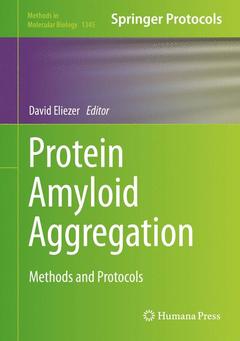Description
Protein Amyloid Aggregation, Softcover reprint of the original 1st ed. 2016
Methods and Protocols
Methods in Molecular Biology Series, Vol. 1345
Coordinator: Eliezer David
Language: English
Subject for Protein Amyloid Aggregation:
Support: Print on demand
Support: Print on demand
Description
/li>Contents
/li>Comment
/li>
This detailed volume focuses on methods for the characterization of aggregation processes that lead to the formation of amyloid fibrils and amyloid oligomers which feature in the etiology of a variety of human disorders collectively known as amyloidoses. The scope of the collection includes techniques for visualizing early steps on the amyloid formation pathway, methods for capturing and characterizing oligomeric, potentially toxic, intermediates, strategies for preparing and characterizing mature amyloid fibrils and approaches for understanding templating and transmission of amyloid aggregates. Written in the highly successful Methods in Molecular Biology series format, the chapters include introductions to their respective topics, lists of the necessary materials and reagents, step-by-step, readily reproducible laboratory protocols and tips on troubleshooting and avoiding known pitfalls.
Authoritative and practical, Protein Amyloid Aggregation: Methods and Protocols serves as an ideal guide for biochemists and biophysicists with an interest in elucidating the mechanisms of protein amyloid formation, as well as chemists, pharmacologists and clinicians with an interest in leveraging an understanding of such mechanisms for the purpose of therapeutic development.
Part I: Labeling Strategies
1. Semisynthesis and Enzymatic Preparation of Post-Translationally Modified α-Synuclein
Bruno Fauvet and Hilal A. Lashuel
2. Isotope-Labeled Amyloids Via Synthesis, Expression, and Chemical Ligation for Use in FTIR, 2D IR, and NMR Studies
Tianqi O. Zhang, Maksim Grechko, Sean D. Moran, and Martin T. Zanni
Part II: Kinetics/Mechanism
3. Inter-Molecular Paramagnetic Relaxation Enhancement (PRE) Studies of Transient Complexes in Intrinsically Disordered Proteins
Maria K. Janowska and Jean Baum
4. Detection of Helical Intermediates During Amyloid Formation by Intrinsically Disordered Polypeptides and Proteins
Andisheh Abedini, Ping Cao, and Daniel P. Raleigh
5. Fluorescence Correlation Spectroscopy: A Tool to Study Protein Oligomerization and Aggregation In Vitro and In Vivo
Bankanidhi Sahoo, Kenneth W. Drombosky, and Ronald Wetzel
6. Deep UV Resonance Raman Spectroscopy for Characterizing Amyloid Aggregation
Joseph D. Handen and Igor K. Lednev
7. Analyzing Tau Aggregation with Electron Microscopy
Carol J. Huseby and Jeff Kuret
Part III: Oligomers
8. Characterization of Amyloid Oligomers by Electrospray Ionization-Ion Mobility Spectrometry-Mass Spectrometry (ESI-IMS-MS)
Charlotte A. Scarff, Alison E. Ashcroft, and Sheena E. Radford
9. Formation and Characterization of α-Synuclein Oligomers
Wojciech Paslawski, Nikolai Lorenzen, and Daniel E. Otzen
10. Fluorescence Methods for Unraveling Oligomeric Amyloid Intermediates
Niels Zijlstra, Nathalie Schilderink, and Vinod
Subramaniam
Part IV: Fibrils
11. Preparation of Amyloid Fibrils for Magic-Angle Spinning Solid-State NMR Spectroscopy
Marcus D. Tuttle, Joseph M. Courtney, Alexander M. Barclay, and Chad M. Rienstra
12. Spin Labeling and Characterization of Tau Fibrils Using Electron Paramagnetic Resonance (EPR)
Virginia Meyer and Martin Margittai
13. Preparation of Crystalline Samples of Amyloid Fibrils and Oligomers
Asher Moshe, Meytal Landau, and David Eisenberg
14. Quenched Hydrogen Exchange NMR of Amyloid Fibrils
Andrei T. Alexandrescu
Part V: Computational Approaches
15. Studying the Early Stages of Protein Aggregation Using Replica Exchange Molecular Dynamics Simulations
Joan-Emma Shea and Zachary A. Levine
16. Computational Methods for Structural and Functional Studies of Alzheimer’s Amyloid Ion Channels
Hyunbum Jang, Fernando Teran Arce, Joon Lee, Alan L. Gillman, Srinivasan Ramachandran, Bruce L. Kagan, Ratnesh Lal, and Ruth Nussinov
17. Analyzing Ensembles of Amyloid Proteins Using Bayesian Statistics
Thomas Gurry, Charles K. Fisher, Molly Schmidt, and Collin M. Stultz
Part VI: Toxicity and Pathology
18. In Vitro Studies of Membrane Permeability Induced by Amyloidogenic Polypeptides Using Large Unilamellar Vesicles
Ping Cao and Daniel P. Raleigh
19. Cell Models to Study Cell-to-Cell Transmission of α-Synuclein
Eun-Jin Bae, He-Jin Lee, and Seung-Jae Lee
20. Preparation of Amyloid Fibrils Seeded from Brain and Meninges
Kathryn P. Scherpelz, Jun-Xia Lu, Robert Tycko, and Stephen C.
MeredithIncludes cutting-edge methods and protocols for studying protein amyloid aggregation
Provides step-by-step detail essential for reproducible results
Contains key notes and implementation advice from the experts
Includes supplementary material: sn.pub/extras




